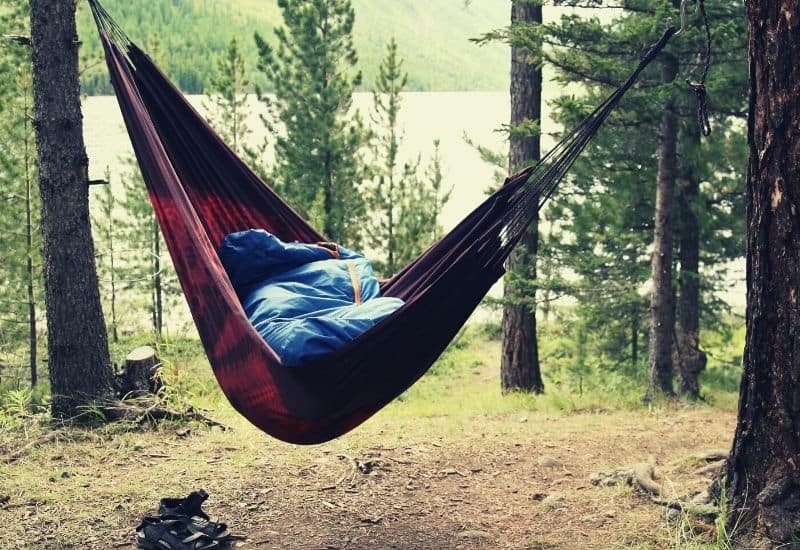Want to swap out your heavy tent for a hammock, but concerned that it might cause back pain?
In recent years, hammocking’s popularity has exploded worldwide. But if you’re new to the hammock camping, you might have a few questions you’d like answered before deciding to switch up your sleeping surface.
One of the most common questions asked of the happy hammockers here at My Open Country is the following: can sleeping in a hammock cause back pain?
For many people a hammock does provide a better night’s sleep than an uncomfortable mattress or thin sleeping pad. However, for others it can be a miserable experience, especially if you already suffer from pre-existing back issues and are unsure how to hammock properly.
That’s why we outline the reasons hammock camping can be good for your back and the reasons it may not. We also discuss ways to minimize the risk of back pain when lying in a hammock so you can get the best night’s sleep possible.
Table of Contents
Are hammocks good for your back?
Is sleeping in a hammock good for your back (and, indeed, the rest of you)? Below, we’ve listed some of the main potential health benefits of sleeping in a hammock.
- Zero-Pressure-Point Sleep
- Sleeping Stability
- Align Your Spine
- A Deeper Sleep
1) Zero-Pressure-Point Sleep
When you sleep in a hammock the fabric contours to your form, resulting in equalized pressure or zero-pressure points on your body. The fabric conforms to your body instead of your body conforming to a harder surface, reducing pressure during your night’s rest.
Sleeping on a bed can put more pressure on your back, butt, and shoulders. A great mattress addresses many of these sleep concerns, but they are expensive and, of course, unavailable when hammock camping. (Unless you are glamping. If you are, drink an extra mimosa for us miserable sods that are dirt-bagging it!)

2) Sleeping Stability
It may seem counter-intuitive, but being wrapped up inside the fabric of a hammock offers more stability when you sleep since tossing and turning becomes more difficult. Shifting around in your sleep is a leading cause of nocturnal back pain, and the stable sleep position hammocking provides could cure those aches and pains you’ve been waking up with.
Do you have pre-existing back pain? Your doctor has probably already told you that the ideal sleeping position to counter your back issues is on your back with your head slightly raised. Because a hammock leaves no alternative, it reduces the risk of inadvertently sabotaging your back’s well-being by shifting into a suboptimal position during the night.
3) Align Your Spine
The “cradling effect” of a hammock limits movement, reducing the likelihood of your back shifting into pain-inducing positions while you sleep. Since one of the main causes of back pain during sleep is a misalignment of the spine, hammocking in this case would provide a more comfortable sleep.
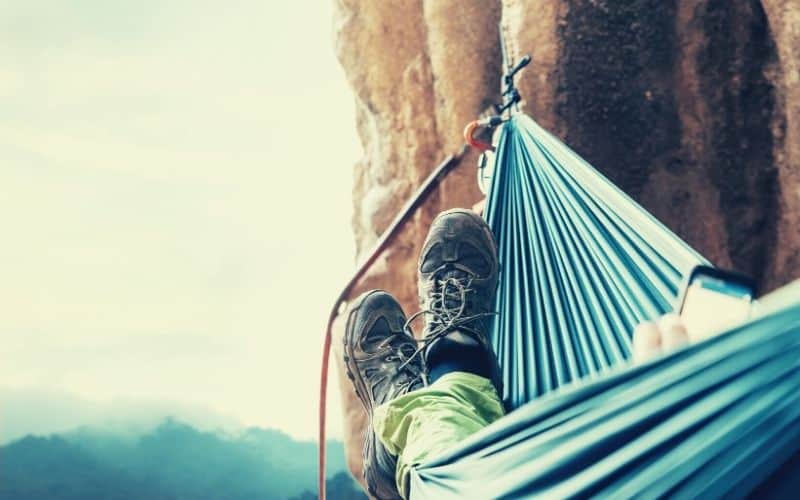
4) A Deeper Sleep
The gentle rocking motion of a hammock can synchronize brain waves and induce deeper states of slumber and may help you fall asleep faster.
The vestibular system informs your brain´s motion and orientation functioning (among other things). The soothing sway seems to affect your vestibular system in a good way when you sleep, just as it does when rocking a baby to sleep.
Are Hammocks bad for Your back?
We wouldn’t be covering this post’s bottom line without including this necessary disclaimer: in some cases, sleeping in a hammock ain’t altogether advisable.
The main potential disadvantages to using a hammock are as follows.
- Exacerbation Of Pre-Existing Problems
- Lower Back Issues
- Human Error
1) Exacerbation of Pre-Existing Problems
For people with pre-existing back problems, hammocking is unlikely to provide a golden ticket to good sleep. In fact, those with conditions like a pinched spinal nerve or scoliosis are more likely to exacerbate their conditions.
2) Lower Back Issues
Most people are likely to find hammocking either helpful as regards back issues, or at least suffer no ill effects, unfortunately, a small percentage will find that the bow in the curve of hammocks causes pain in their lower back.
All humans are created equal, but all bodies are created with various quirks and idiosyncrasies that make no two alike. And some of them, alas, just don’t take kindly to the airborne sleeping experience.
If you have had back issues in the past or have any doubts, we recommend you ask your physician before you consider switching up your nighttime routine and definitely before you go sleeping in a hammock long term.
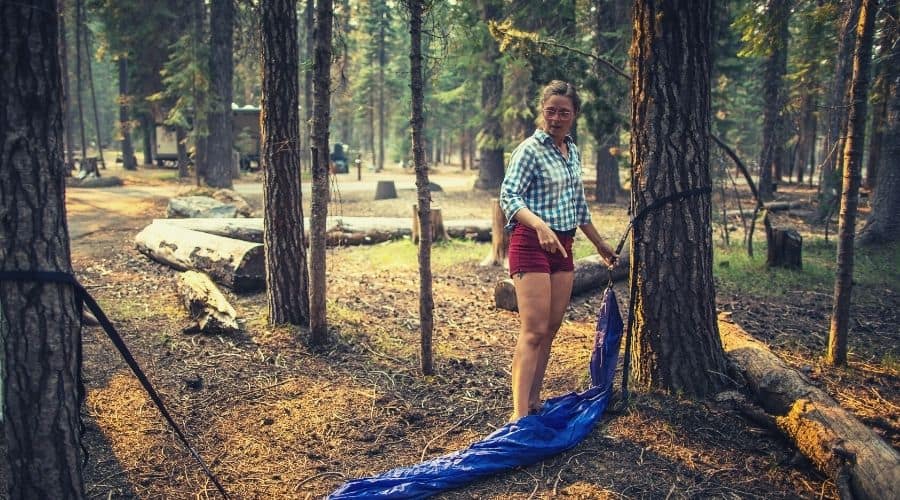
3) Human Error
When sleeping in a hammock care is required to ensure your setup is comfortable and optimized for trouble-free sleep as regards your back.
Sleeping on a camping mattress on the other hand is easy. You inflate the thing, throw it in your tent, and—hey presto!—you’re good to go (to sleep)!
What Can I do to reduce back issues when Hammock Sleeping?
Nothing’s more likely to lead to an uncomfortable night in the hammock than incorrect set-up. Below, we’ve added a few tips to help you set up for success.
- Learn the Ropes
- Pillow Up
- Lie Diagonally
- Use a Mat or Underquilt
- Under-Knee Support
1) Learn the Ropes
Learning the ropes for setting up a hammock correctly is critical not only for safety but also for comfort. Key things to remember include the angles you hang at, the correct distance from the ground, and ensuring everything is secure.
First up, check your angles, ensuring the angle between your straps and anchors is roughly 30 degrees. Secondly, make sure the bottom of your hammock is around 18-20 inches from the ground when you’re inside. Thirdly, make sure all your hardware is fit to the task, checking the weight capacity of the hammock and straps and ensuring your anchors are sturdy.
This topic is covered in more detail in our post on safe and sound hanging practice.
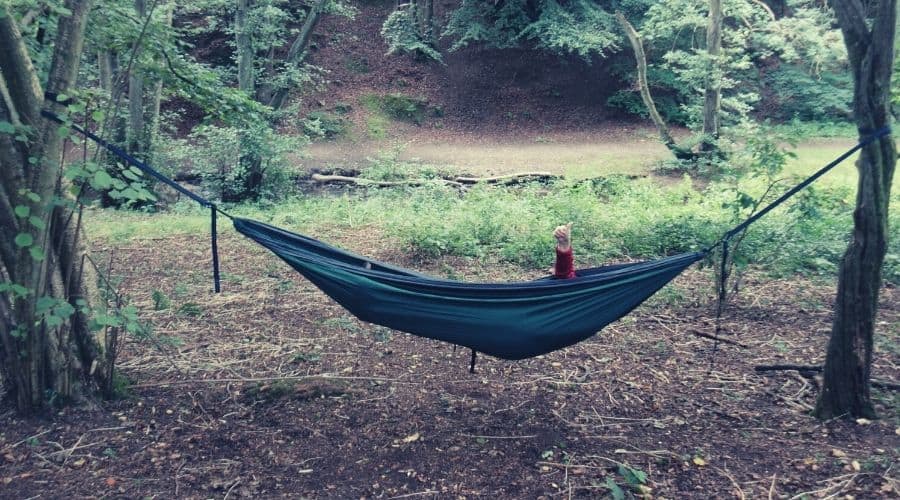
2) Pillow Up
Use a pillow (or clothes stuffed into a stuff sack) for your neck when you sleep. You might think you don’t need something to support your neck and head when held in midair by fabric and cords, but you will quickly feel the absence of one when sleeping in a hammock.
3) Lie Diagonally
Sleeping diagonally in your hammock creates more space and allows you to stretch out enough for your muscles to relax. This also reduces the “droop” in the curve of the fabric.
4) Use a Mat or Underquilt
Lay out your ground mat or underquilt in the hammock. This provides more support and a cushioning layer of soft foam or fabric between your body and the material.
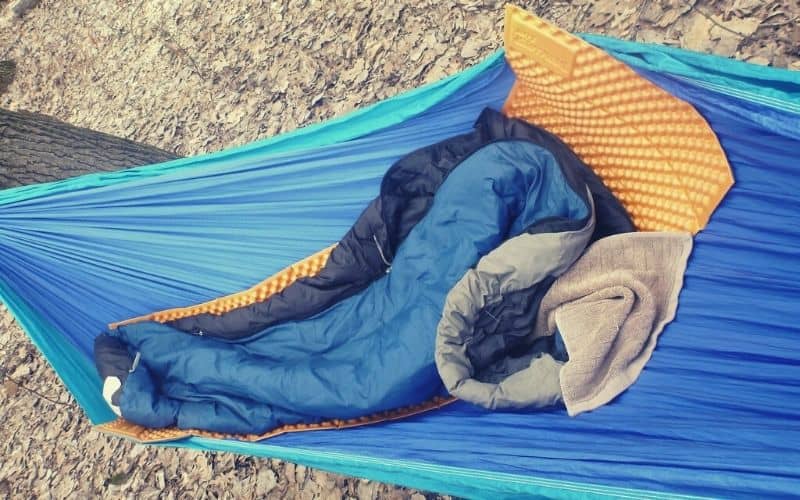
5) Under-Knee Support
Place a pillow or a blanket (or a down jacket when on the trail) under your knees for additional back support.
RELATED: How to clean your hammock
The Verdict: Are Hammocks Bad For Your Back?
So, is sleeping in a hammock bad for your back? Every person will respond differently to the hammocking experience, so ease yourself into it gently. Start with shorter daytime sessions before trying to pull an all-nighter. In time, we’re sure, 95% of you will be swaying your way to many nights of comfortable, pain-free, and deep sleep.
There are a lot of anecdotal benefits and negatives about hammock sleep out there. Most of the information online, however, comes from hammock companies. They, predictably, do not provide an altogether impartial look at the actual effects that their merchandise can have on a body or offer any suggestion that camping hammocks may actually cause back pain for some sleepers.
The take-home? Take these (often) lofty claims with a pinch of salt and be aware that you’ll never know if it will be for you until you try it.
Are you tempted to try hammock camping on your next trip? Or have you decided to stick with your tent? Did we miss anything? Let us know in the comments below!
